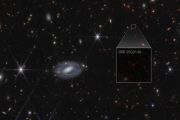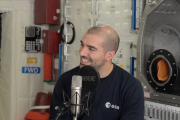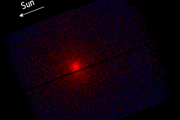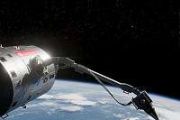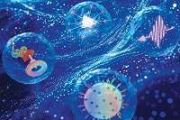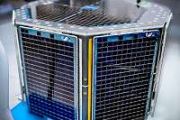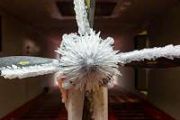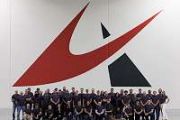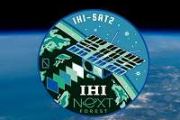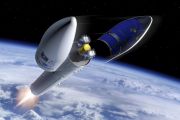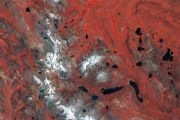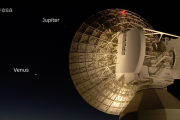
Copernical Team
Quadrantid Meteor Shower offers 'perfect New Year treat'
 One of Earth's most spectacular meteor showers will light up the night sky with an array of dazzling 'shooting stars' over the next fortnight.
Stargazers will have a chance to catch a glimpse of the Quadrantids between now and 12 January 2025. However, the peak time to get the best look will be on 3 January 2025, either first thing in the morning before dawn or in the evening after sunset.
One of Earth's most spectacular meteor showers will light up the night sky with an array of dazzling 'shooting stars' over the next fortnight.
Stargazers will have a chance to catch a glimpse of the Quadrantids between now and 12 January 2025. However, the peak time to get the best look will be on 3 January 2025, either first thing in the morning before dawn or in the evening after sunset. SpaceX delays launch of Thuraya 4 mission for UAE satellite company
 SpaceX has delayed the launch of its Thuraya 4 mission from the Cape Canaveral Space Force Station in Florida until Friday, the company announced on its website Thursday.
Space 42's Thuraya 4 mission is operated in conjunction with Yahsat, a global satellite company based in the United Arab Emirates. The Thuraya 4 is a communications satellite that will operate in geosynchronous orbit,
SpaceX has delayed the launch of its Thuraya 4 mission from the Cape Canaveral Space Force Station in Florida until Friday, the company announced on its website Thursday.
Space 42's Thuraya 4 mission is operated in conjunction with Yahsat, a global satellite company based in the United Arab Emirates. The Thuraya 4 is a communications satellite that will operate in geosynchronous orbit, Space Launch Delta 45 breaks records, remains busiest spaceport in the world in 2024
 Space Launch Delta 45 continued to "set the pace for space" as the world's busiest spaceport in 2024. The SLD 45 team, composed of military and civilian Guardians and Airmen at Patrick Space Force Base and Cape Canaveral Space Force Station, enabled 93 launches from the Eastern Range in 2024.
Collectively, this team, comprised of total force personnel, surged to send 93 rockets into space,
Space Launch Delta 45 continued to "set the pace for space" as the world's busiest spaceport in 2024. The SLD 45 team, composed of military and civilian Guardians and Airmen at Patrick Space Force Base and Cape Canaveral Space Force Station, enabled 93 launches from the Eastern Range in 2024.
Collectively, this team, comprised of total force personnel, surged to send 93 rockets into space, PLD Space advances business operations in 2024
 PLD Space has concluded 2024 with remarkable progress, securing its place as a major player in the global space launcher industry. The company has raised over 170 million euros through various funding initiatives, enabling rapid development and strategic expansion.
Throughout 2024, PLD Space secured significant investments, including a 40.5 million euro grant under the Spanish small satell
PLD Space has concluded 2024 with remarkable progress, securing its place as a major player in the global space launcher industry. The company has raised over 170 million euros through various funding initiatives, enabling rapid development and strategic expansion.
Throughout 2024, PLD Space secured significant investments, including a 40.5 million euro grant under the Spanish small satell Northern lights to ring in New Year's Eve in parts of United States
 The northern lights are forecast to put on a New Year's show as far south as Illinois, New York and Oregon starting Monday night, according to the National Oceanic and Atmospheric Administration.
The powerful geomagnetic storm, or coronal mass ejection of solar material, is classified as a strong warning G3 that could produce northern lights visible through New Year's Eve in as many as
The northern lights are forecast to put on a New Year's show as far south as Illinois, New York and Oregon starting Monday night, according to the National Oceanic and Atmospheric Administration.
The powerful geomagnetic storm, or coronal mass ejection of solar material, is classified as a strong warning G3 that could produce northern lights visible through New Year's Eve in as many as Passed the Turing Test living in Turing Futures
 A recent perspective published in the Nov. 13 issue of Intelligent Computing has highlighted how modern artificial intelligence systems have fulfilled Alan Turing's vision of machines capable of learning from experience and engaging in human-like conversations. Authored by Bernardo Goncalves of the University of Sao Paulo and University of Cambridge, the paper explores how transformer-based AI s
A recent perspective published in the Nov. 13 issue of Intelligent Computing has highlighted how modern artificial intelligence systems have fulfilled Alan Turing's vision of machines capable of learning from experience and engaging in human-like conversations. Authored by Bernardo Goncalves of the University of Sao Paulo and University of Cambridge, the paper explores how transformer-based AI s Mystery of supra-thermal ions in fusion plasmas solved by advanced collision models
 The pursuit of nuclear fusion as a clean and abundant energy source has made significant strides with the advent of inertial confinement fusion (ICF). This technology relies on compressing deuterium-tritium (DT) fuel to extreme temperatures and pressures to initiate fusion. While neutrons generated in this process primarily contribute to electricity production, alpha particles remain in the fuel
The pursuit of nuclear fusion as a clean and abundant energy source has made significant strides with the advent of inertial confinement fusion (ICF). This technology relies on compressing deuterium-tritium (DT) fuel to extreme temperatures and pressures to initiate fusion. While neutrons generated in this process primarily contribute to electricity production, alpha particles remain in the fuel A call for collaboration in solar energy meteorology research
 Solar energy has become a leading renewable energy source, renowned for its efficiency and cost-effectiveness in reducing dependency on fossil fuels. However, optimizing solar energy production presents challenges that extend beyond traditional engineering solutions, prompting the rise of a specialized field known as solar energy meteorology.
This interdisciplinary field focuses on evaluat
Solar energy has become a leading renewable energy source, renowned for its efficiency and cost-effectiveness in reducing dependency on fossil fuels. However, optimizing solar energy production presents challenges that extend beyond traditional engineering solutions, prompting the rise of a specialized field known as solar energy meteorology.
This interdisciplinary field focuses on evaluat Are we ready for the ethical challenges of AI and robots
 Artificial intelligence (AI) and AI-enabled robots are rapidly integrating into everyday life, evolving from simple tools into entities that resemble human partners. This transformation brings critical ethical and legal challenges, ranging from privacy and safety to the regulation of increasingly autonomous systems.
The *Cambridge Handbook of the Law, Policy, and Regulation for Human-Robot
Artificial intelligence (AI) and AI-enabled robots are rapidly integrating into everyday life, evolving from simple tools into entities that resemble human partners. This transformation brings critical ethical and legal challenges, ranging from privacy and safety to the regulation of increasingly autonomous systems.
The *Cambridge Handbook of the Law, Policy, and Regulation for Human-Robot DARPA's ASIMOV seeks to develop Ethical Standards for Autonomous Systems
 CoVar, a prominent developer of AI and machine learning solutions for the Department of Defense, has secured a multi-year contract with the Defense Advanced Research Projects Agency (DARPA) to contribute to the Autonomy Standards and Ideals with Military Operational Values (ASIMOV) program. This initiative aims to establish a quantifiable framework for assessing the ethical readiness of autonomo
CoVar, a prominent developer of AI and machine learning solutions for the Department of Defense, has secured a multi-year contract with the Defense Advanced Research Projects Agency (DARPA) to contribute to the Autonomy Standards and Ideals with Military Operational Values (ASIMOV) program. This initiative aims to establish a quantifiable framework for assessing the ethical readiness of autonomo 




